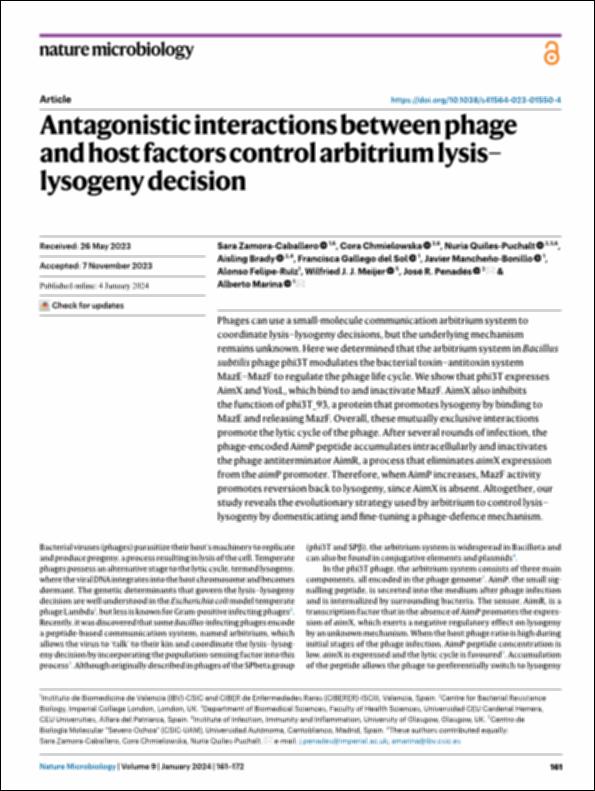Please use this identifier to cite or link to this item:
http://hdl.handle.net/10637/15244Antagonistic interactions between phage and host factors control arbitrium lysis–lysogeny decision
| Title: | Antagonistic interactions between phage and host factors control arbitrium lysis–lysogeny decision |
| Authors : | Zamora Caballero, Sara Chmielowska, Cora Quiles Puchalt, Nuria Brady, Aisling Gallego del Sol, Francisca Mancheño Bonillo, Javier Felipe Ruiz, Alonso Meijer, Wilfried J. J. Penadés Casanova, José Rafael Marina, Alberto |
| Keywords: | Célula; Cells; Biología celular; Cell biology; Biofísica; Biophysics; Ecología microbiana; Microbial ecology; Biología molecular; Molecular biology |
| Publisher: | Springer Nature |
| Citation: | Zamora-Caballero, S., Chmielowska, C., Quiles-Puchalt, N., Brady, A., Del Sol, F.G., Mancheño-Bonillo, J., Felipe-Ruíz, A., Meijer, W. J.J., Penadés, J.R. & Marina, A. (2024). Antagonistic interactions between phage and host factors control arbitrium lysis-lysogeny decision. Nature Microbiology, vol. 9, i. 1 (jan.), pp. 161–172. DOI: https://doi.org/10.1038/s41564-023-01550-4 |
| Abstract: | Phages can use a small-molecule communication arbitrium system to coordinate lysis–lysogeny decisions, but the underlying mechanism remains unknown. Here we determined that the arbitrium system in Bacillus subtilis phage phi3T modulates the bacterial toxin–antitoxin system MazE–MazF to regulate the phage life cycle. We show that phi3T expresses AimX and YosL, which bind to and inactivate MazF. AimX also inhibits the function of phi3T_93, a protein that promotes lysogeny by binding to MazE and releasing MazF. Overall, these mutually exclusive interactions promote the lytic cycle of the phage. After several rounds of infection, the phage-encoded AimP peptide accumulates intracellularly and inactivates the phage antiterminator AimR, a process that eliminates aimX expression from the aimP promoter. Therefore, when AimP increases, MazF activity promotes reversion back to lysogeny, since AimX is absent. Altogether, our study reveals the evolutionary strategy used by arbitrium to control lysis–lysogeny by domesticating and fine-tuning a phage-defence mechanism. |
| URI: | http://hdl.handle.net/10637/15244 |
| Rights : | Open Access http://creativecommons.org/licenses/by/4.0/deed.es |
| ISSN: | 2058-5276 (Electrónico) |
| Issue Date: | 4-Jan-2024 |
| Center : | Universidad Cardenal Herrera-CEU |
| Appears in Collections: | Dpto. Ciencias Biomédicas |
Items in DSpace are protected by copyright, with all rights reserved, unless otherwise indicated.


